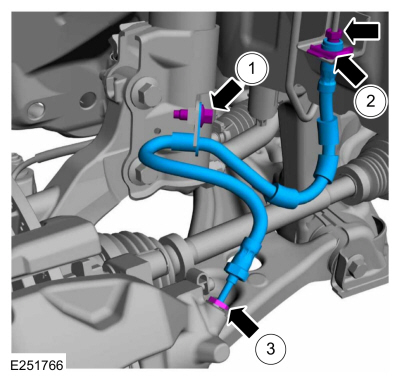Ford Ecosport: Steering Wheel and Column Electrical Components / Description and Operation - Steering Wheel and Column Electrical Components - Overview
Steering Column Switches Overview
The steering column switches are located on and around the steering column. They enable the driver to control various vehicle functions while remaining focused on driving. The steering column switches consist of:
-
Left multifunction switch - mounted on the left side of the SCCM and is used:
-
to control the turn signals, low/high beam selection and the flash-to-pass feature.
Refer to: Exterior Lighting (417-01 Exterior Lighting) .
-
to control the turn signals, low/high beam selection and the flash-to-pass feature.
-
Right multifunction switch - mounted on the right side of the SCCM and is used:
-
to control the front windshield wipers/washers, and
the rear window wiper/washer. The right multifunction switch can be
serviced separately from the SCCM .
Refer to: Wipers and Washers (501-16 Wipers and Washers) .
-
to control the front windshield wipers/washers, and
the rear window wiper/washer. The right multifunction switch can be
serviced separately from the SCCM .
-
Steering wheel switches - mounted on the front of the
steering wheel and can be serviced separately from the steering wheel.
These are used to access settings and controls displayed in the message
center or for control of the cruise control system, the audio system and
the SYNC® system.
-
For the message center (left upper switch),
Refer to: Message Center - System Operation and Component Description (413-01 Instrumentation, Message Center and Warning Chimes, Description and Operation).
-
For the cruise control system (left lower switch),
Refer to: Cruise Control - System Operation and Component Description (419-03 Cruise Control, Description and Operation).
- For the audio system (right upper switch), Refer to the appropriate section in Group 415 for the procedure.
- For the SYNC® system (right lower switch), Refer to the appropriate section in Group 415 for the procedure.
-
For the message center (left upper switch),
The steering column and steering wheel switches interface with other modules and components on the vehicle through the SCCM , which communicates on the High Speed Controller Area Network 2 (HS2-CAN).
Conventional Ignition Switch Overview
The conventional ignition switch is controlled by the ignition lock cylinder and key. The ignition lock cylinder and ignition switch are connected mechanically. Turning the ignition lock cylinder places the ignition switch into the desired position. The available ignition switch positions are:
- OFF
- ACC
- ON
- START
When placed in ACC or ON, the ignition switch provides voltage inputs to the BCM .
When placed in START, the ignition switch provides voltage inputs to the BCM and PCM .
Push Button Start Ignition System Overview
The push button start ignition system is used to place the ignition in the ON or OFF mode and to start or shut off the vehicle powertrain. The push button ignition switch is located to the right of the steering wheel in the instrument panel.
Steering Column Lock System Overview
The steering column lock deters vehicle theft by locking the steering column and preventing the steering wheel from being used to turn the front wheels.
Heated Steering Wheel Overview
The heated steering wheel system consists of the following components:
- Steering wheel heater elements (part of steering wheel)
- Steering wheel temperature sensor (part of steering wheel)
- Heated steering wheel switch
- SCCM
 Description and Operation - Steering Wheel and Column Electrical Components - System Operation and Component Description
Description and Operation - Steering Wheel and Column Electrical Components - System Operation and Component Description
System Operation
System Diagram - Conventional Ignition Switch
Item
Description
1
Ignition Switch
2
START
3
ACC
4
ON
5
HS1-CAN
6
Gear Selector Lever
7
Ignition Key Inhibit Solenoid
8
PCM
9
BCM
10
Run/Start Relay
Network Message Chart - Conventiona..
Other information:
Ford Ecosport 2014-2025 Service and Repair Manual: General Procedures - Power Door Window Initialization
Initialization NOTE: NOTE: Initialization is required to learn both the full UP and full DOWN positions and the profile of the glass as it travels through the glass channel. Once initialized, obstacle detection is enabled. NOTE: A new door module or de-initialized window does not operate in one-touch up mode until it has been initialized. Turn the igni..
Ford Ecosport 2014-2025 Service and Repair Manual: Removal and Installation - Camshaft Position (CMP) Sensor
Materials Name Specification Engine Oil - SAE 5W-20 - Synthetic Blend Motor OilXO-5W20-Q1SP WSS-M2C945-B1 Removal NOTE: Removal steps in this procedure may contain installation details. Remove the engine appearance cover. LH CMP sensor Disconnect the electrical connector. Remove ..


